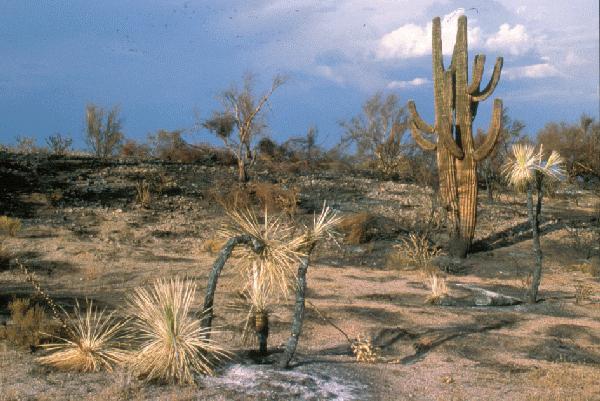- Home
- About S&T
- Taxa/Organisms
- Ecosystems
- Issues
- Methods & Tools
- Reports & Publications
- Location
- Search
Publisher: USGS | Science Center: Fort Collins Science Center (FORT, Ft. Collins) | Format: URL
www.fort.usgs.gov — USGS scientist Craig Allen, along with Tom Swetnam of the University of Arizona Laboratory of Tree-Ring Research, Scott Anderson of Northern Arizona University, and others, have been developing landscape-level fire histories in the Jemez and Sangre de Cristo Mountains of northern New Mexico. These histories are compiled using charcoal deposits More...

March 2009 | Publisher: USGS | Science Center: Western Ecological Research Center (WERC, Sacramento) | Format: .PDF
www.werc.usgs.gov — Fire occurs in many North American ecosystems, and most of these systems are resilient to fires that occur within a broad range of variability in frequency and intensity. In a recent USFS publication (General Technical Report PNW-GTR-779, ), USGS scientist Jon Keeley led a team of scientists from various agencies and academic institutions in More...

July 2007 | Publisher: Other (Ecological Society of America (ESA) Journal) | Format: URL
www.esajournals.org — Periodic wildfire maintains the integrity and species composition of many ecosystems, including the Mediterranean-climate shrublands of California. However, human activities alter natural fire regimes, which can lead to cascading ecological effects. Increased human ignitions at the wildland-urban interface (WUI) have recently gained attention, but More...

Publisher: Other Federal Agency (United States Forest Service (USFS)) | Format: .PDF
www.fs.fed.us — USGS scientist Jon Keeley led a team of scientists from various agencies and academic institutions in developing a framework that will inform fire management of ecosystems. This review uses a scientific synthesis to provide an ecological foundation for management of diverse ecosystems. Ecosystem-based management requires different strategies on More...

Publisher: USGS | Format: URL
burnseverity.cr.usgs.gov — This project addresses the need to quantify fire effects over large, often-remote regions and long time intervals, reflecting collaborative efforts to bring previous research into operational implementation for fire managers and scientists. The project focuses on National Park Service Units and adjoining lands throughout the U.S., combining More...

Publisher: USGS | Science Center: Northern Rocky Mountain Science Center (NRMSC, Bozeman) | Format: URL
nrmsc.usgs.gov — This site reflects satellite image mosaics of recent fire years from western Montana and central Idaho. Mosaic PDF versions of maps from 2000, 2003, and 2007 are available, and are intended to assist by providing the location of notable burns for the more significant fire years in western Montana and central Idaho. The aim is also to provide a More...

Publisher: USGS | Science Center: Western Ecological Research Center (WERC, Sacramento) | Format: URL
www.werc.usgs.gov — This issues overview and its resources deal with the spread of nonnative grasses in the Sonoran desert of Arizona has increased the risk of devastating fires by ignited fuel. The saguaro cactuses and desert tortoises have suffered catastrophic population losses as a result of these fires fueled by nonnative grasses. Read more about nonnative More...

Publisher: Invasive Species Information Node | Format: URL
invasivespecies.nbii.gov — The CerroGrande WildFire Invasive Species Mapping Project utilizes predictive spatial models to predict the total number of plant species richness likely to be found for any given location within the cerro grande wildfire (New Mexico). The number of invasive species was found to be correlated with areas of high native species richness.

Publisher: USGS | Science Center: Forest and Rangeland Ecosystem Science Center (FRESC, Corvallis) | Format: URL
fresc.usgs.gov — Fire rehabilitation programs have existed within federal agencies since the early 1960s. The data that exists are stored in field office files and are often not available for other managers to use when planning new emergency stabilization and rehabilitation treatments. The objectives of this project are to facilitate analysis of emergency More...

Publisher: USGS | Science Center: Western Ecological Research Center (WERC, Sacramento) | Format: URL
www.werc.usgs.gov — Where nonnative plant species have invaded wildlands or have potential to invade, fire may influence their abundance and the effects of the nonnative species on native plant communities. USGS scientists and colleagues have contributed chapters to a volume that synthesizes scientific information regarding wildland fire and nonnative invasive plant More...

Publisher: USGS | Science Center: Western Ecological Research Center (WERC, Sacramento) | Format: URL
www.werc.usgs.gov — This study, funded by the Joint Fire Science Program, investigates how postfire treatments affect fuel load, fuel structure, plant community composition, and potential fire behavior on the west side of the Sierra Nevada Mountain Range. The four major fire areas in this study encompass a diverse range of silvicultural and environmental conditions More...

Publisher: USGS | Science Center: Alaska Science Center (ASC, Anchorage) | Format: URL
alaska.usgs.gov — Experts believe that catastrophic damage from wildland fire probably will continue to increase across the nation and large fires in recent years have caused concern with land managers as to how to better assess the impacts of fire on landscapes. This is especially true for Alaska's boreal region, where fire frequency, size, and severity appear to More...
